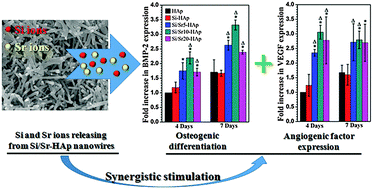Strontium (Sr) strengthens the silicon (Si) upon osteoblast proliferation, osteogenic differentiation and angiogenic factor expression
Abstract
The control over the chemical compositions of hydroxyapatite [Ca10(PO4)6(OH)2, HAp] bioceramic materials is of great importance for their application. In the present study, the silicon (Si) substituted HAp (Si-HAp) and the Si and strontium (Sr) co-substituted HAp (Si/Sr-HAp) nanowires were synthesized via the hydrothermal transformation of calcium silicate (CS) and Sr-substituted calcium silicate (Sr–CS) powders as the precursors, respectively, in Na3PO4 aqueous solution. Then the effects of the Si substitution and Si/Sr co-substitutions on the proliferation and differentiation of osteoblast cells (MC3T3-E1) were investigated. The results revealed that the synthetic products were wire-shaped with a diameter of ∼60 nm and a length of up to several micrometers, while the Sr substitution amount of Si/Sr-HAp nanowires could be tailored by regulating the Sr substitution level. Compared with pure HAp materials, the Si substitution could enhance the osteoblast growth and differentiation. Moreover, the substitution of the materials by a second functional element of Sr ions in appropriate levels could further promote the proliferation, osteogenic differentiation and angiogenic factor expression of osteoblasts. Our study suggests that the Sr can strengthen the Si upon osteoblast proliferation, osteogenic differentiation and angiogenic factor expression, which might be used as bioactive materials for bone regeneration applications.


 Please wait while we load your content...
Please wait while we load your content...